Human Resource Economics: Pay and Performance in Healthcare (Report)
VerifiedAdded on 2020/04/21
|11
|2615
|305
Report
AI Summary
This report examines the complexities of pay and performance within the Australian healthcare industry, focusing on the effectiveness of pay-for-performance (P4P) models. It analyzes the deficiencies in current P4P systems, drawing on economic literature and the efficiency wage theory to understand the relationship between performance and pay. The report highlights the Bundaberg Base Hospital scandal as a case study, illustrating the need for improved clinical practice and payment structures. It explores performance evaluation techniques, the role of subjective and objective measures, and the challenges of designing effective incentive schemes. The analysis considers the impact of P4P on healthcare providers, patient outcomes, and the broader economic implications, including turnover costs and the balance between efficiency wages and performance-based compensation. The report also discusses various P4P initiatives in Australia, such as the General Practice Immunisation Incentive Scheme, and provides insights into the mixed results and ongoing debates surrounding these models.
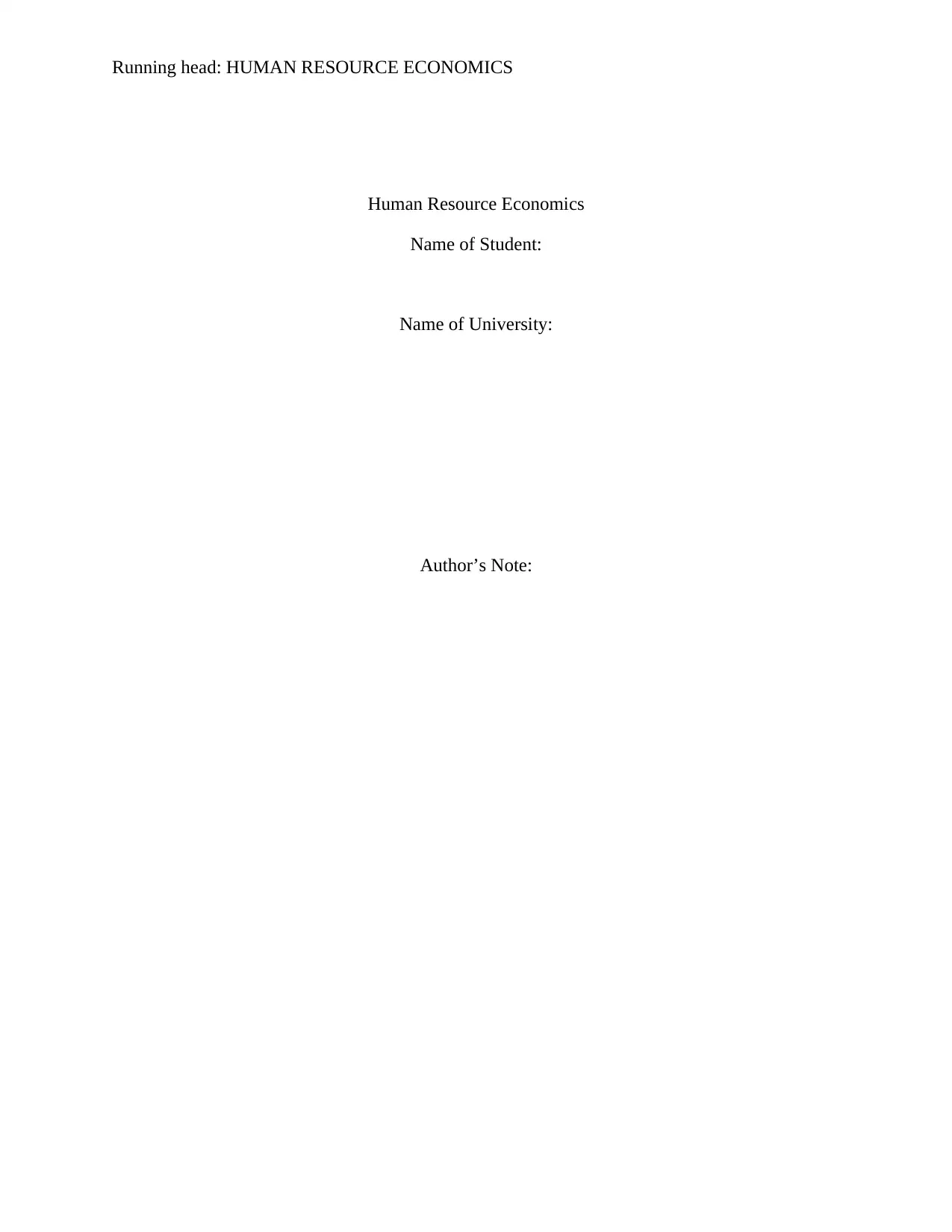
Running head: HUMAN RESOURCE ECONOMICS
Human Resource Economics
Name of Student:
Name of University:
Author’s Note:
Human Resource Economics
Name of Student:
Name of University:
Author’s Note:
Paraphrase This Document
Need a fresh take? Get an instant paraphrase of this document with our AI Paraphraser
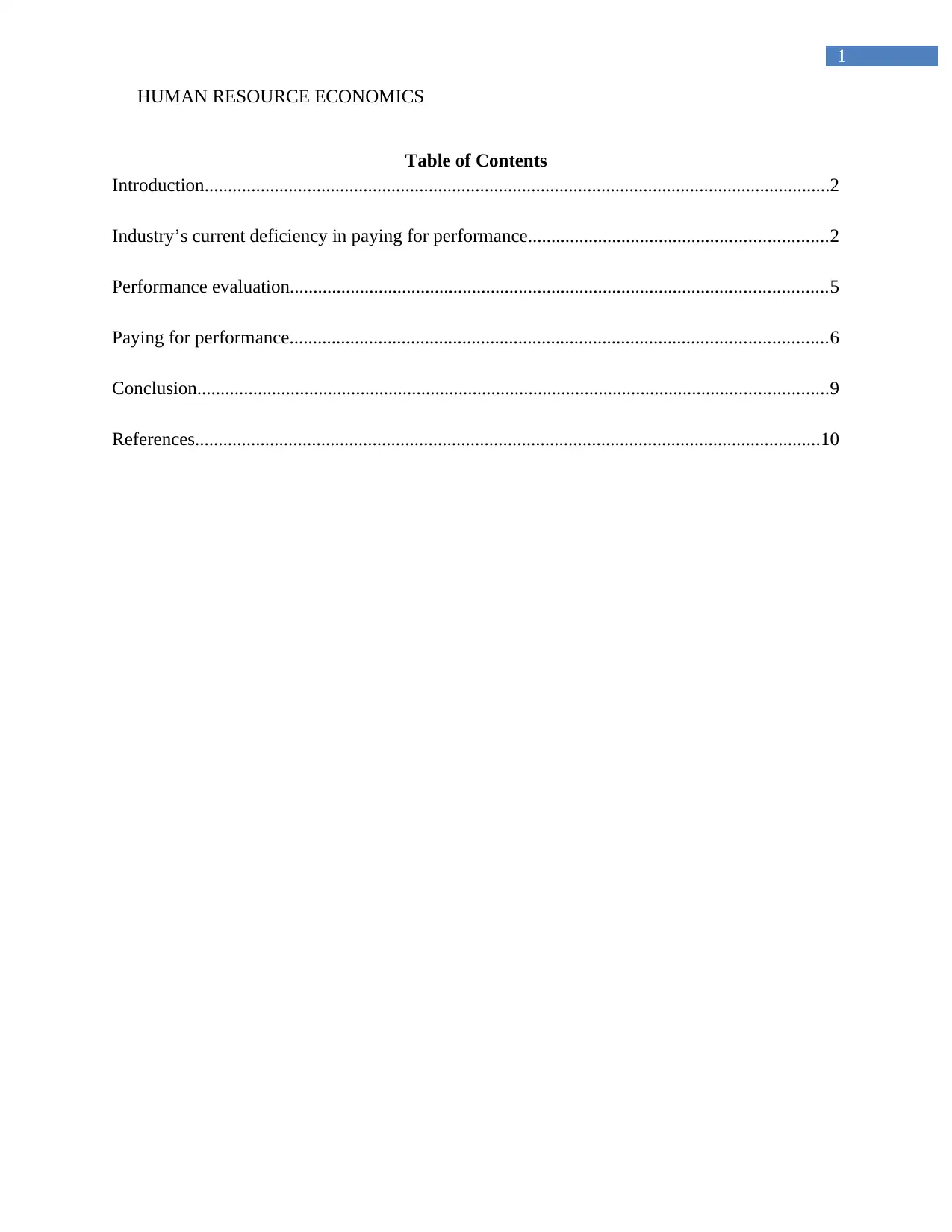
1
HUMAN RESOURCE ECONOMICS
Table of Contents
Introduction......................................................................................................................................2
Industry’s current deficiency in paying for performance................................................................2
Performance evaluation...................................................................................................................5
Paying for performance...................................................................................................................6
Conclusion.......................................................................................................................................9
References......................................................................................................................................10
HUMAN RESOURCE ECONOMICS
Table of Contents
Introduction......................................................................................................................................2
Industry’s current deficiency in paying for performance................................................................2
Performance evaluation...................................................................................................................5
Paying for performance...................................................................................................................6
Conclusion.......................................................................................................................................9
References......................................................................................................................................10
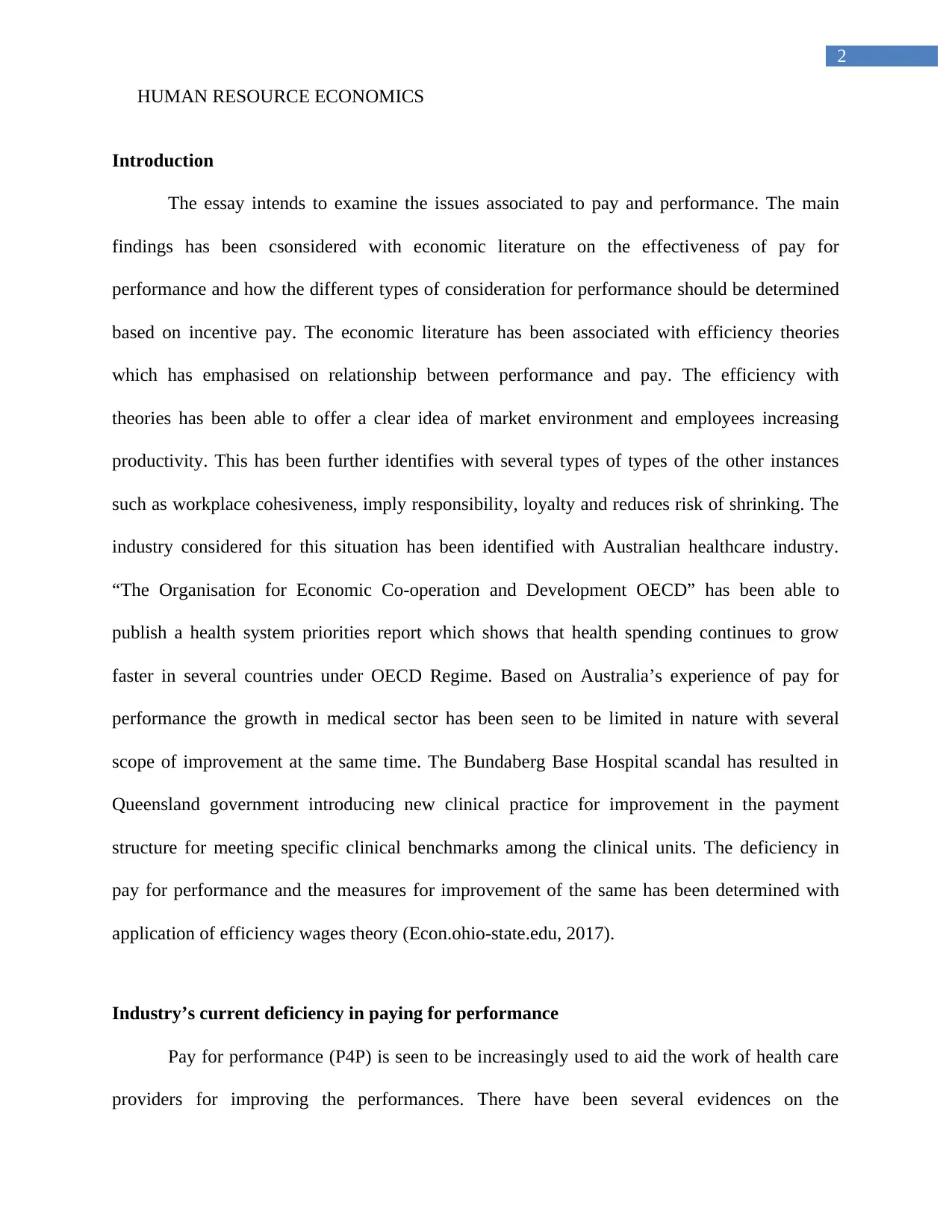
2
HUMAN RESOURCE ECONOMICS
Introduction
The essay intends to examine the issues associated to pay and performance. The main
findings has been csonsidered with economic literature on the effectiveness of pay for
performance and how the different types of consideration for performance should be determined
based on incentive pay. The economic literature has been associated with efficiency theories
which has emphasised on relationship between performance and pay. The efficiency with
theories has been able to offer a clear idea of market environment and employees increasing
productivity. This has been further identifies with several types of types of the other instances
such as workplace cohesiveness, imply responsibility, loyalty and reduces risk of shrinking. The
industry considered for this situation has been identified with Australian healthcare industry.
“The Organisation for Economic Co-operation and Development OECD” has been able to
publish a health system priorities report which shows that health spending continues to grow
faster in several countries under OECD Regime. Based on Australia’s experience of pay for
performance the growth in medical sector has been seen to be limited in nature with several
scope of improvement at the same time. The Bundaberg Base Hospital scandal has resulted in
Queensland government introducing new clinical practice for improvement in the payment
structure for meeting specific clinical benchmarks among the clinical units. The deficiency in
pay for performance and the measures for improvement of the same has been determined with
application of efficiency wages theory (Econ.ohio-state.edu, 2017).
Industry’s current deficiency in paying for performance
Pay for performance (P4P) is seen to be increasingly used to aid the work of health care
providers for improving the performances. There have been several evidences on the
HUMAN RESOURCE ECONOMICS
Introduction
The essay intends to examine the issues associated to pay and performance. The main
findings has been csonsidered with economic literature on the effectiveness of pay for
performance and how the different types of consideration for performance should be determined
based on incentive pay. The economic literature has been associated with efficiency theories
which has emphasised on relationship between performance and pay. The efficiency with
theories has been able to offer a clear idea of market environment and employees increasing
productivity. This has been further identifies with several types of types of the other instances
such as workplace cohesiveness, imply responsibility, loyalty and reduces risk of shrinking. The
industry considered for this situation has been identified with Australian healthcare industry.
“The Organisation for Economic Co-operation and Development OECD” has been able to
publish a health system priorities report which shows that health spending continues to grow
faster in several countries under OECD Regime. Based on Australia’s experience of pay for
performance the growth in medical sector has been seen to be limited in nature with several
scope of improvement at the same time. The Bundaberg Base Hospital scandal has resulted in
Queensland government introducing new clinical practice for improvement in the payment
structure for meeting specific clinical benchmarks among the clinical units. The deficiency in
pay for performance and the measures for improvement of the same has been determined with
application of efficiency wages theory (Econ.ohio-state.edu, 2017).
Industry’s current deficiency in paying for performance
Pay for performance (P4P) is seen to be increasingly used to aid the work of health care
providers for improving the performances. There have been several evidences on the
⊘ This is a preview!⊘
Do you want full access?
Subscribe today to unlock all pages.

Trusted by 1+ million students worldwide
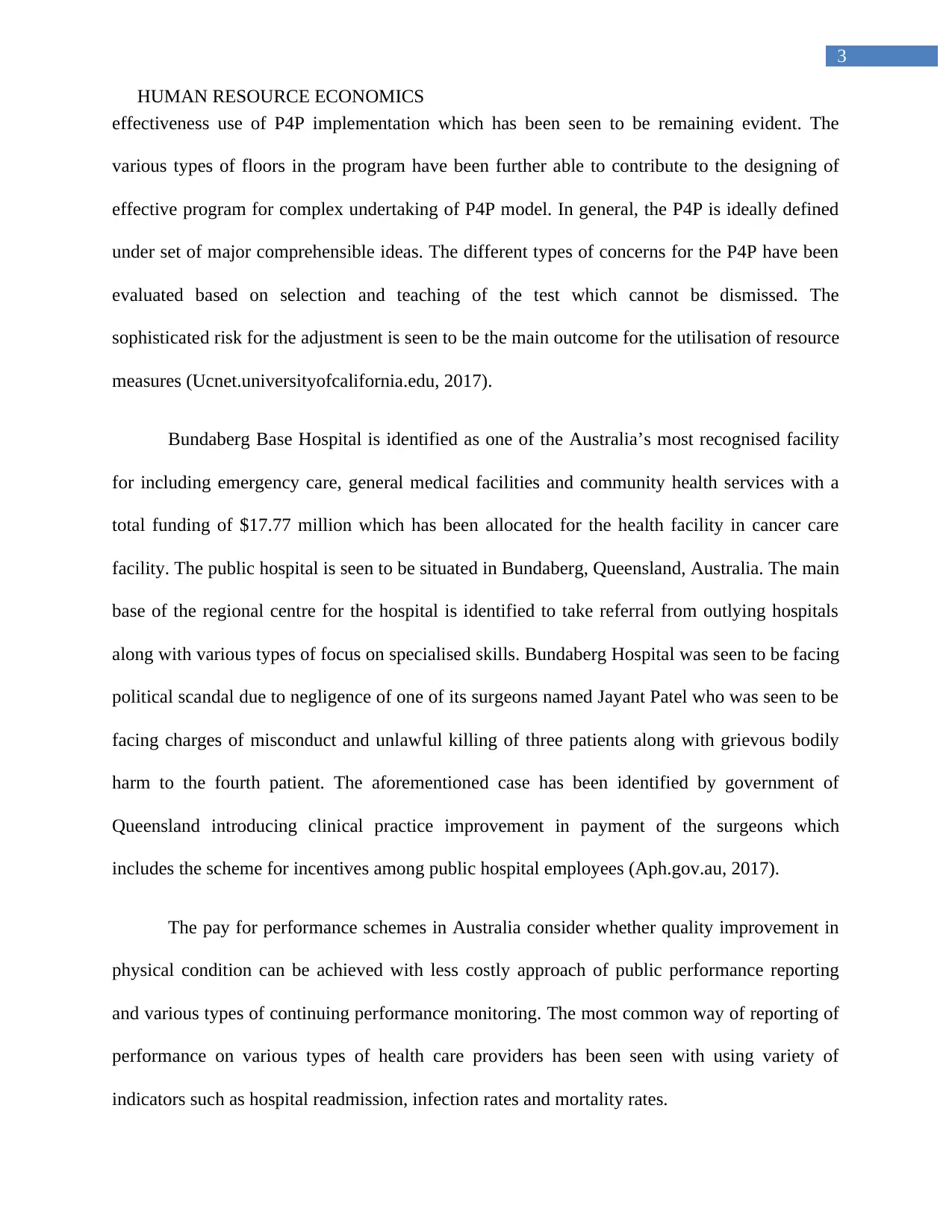
3
HUMAN RESOURCE ECONOMICS
effectiveness use of P4P implementation which has been seen to be remaining evident. The
various types of floors in the program have been further able to contribute to the designing of
effective program for complex undertaking of P4P model. In general, the P4P is ideally defined
under set of major comprehensible ideas. The different types of concerns for the P4P have been
evaluated based on selection and teaching of the test which cannot be dismissed. The
sophisticated risk for the adjustment is seen to be the main outcome for the utilisation of resource
measures (Ucnet.universityofcalifornia.edu, 2017).
Bundaberg Base Hospital is identified as one of the Australia’s most recognised facility
for including emergency care, general medical facilities and community health services with a
total funding of $17.77 million which has been allocated for the health facility in cancer care
facility. The public hospital is seen to be situated in Bundaberg, Queensland, Australia. The main
base of the regional centre for the hospital is identified to take referral from outlying hospitals
along with various types of focus on specialised skills. Bundaberg Hospital was seen to be facing
political scandal due to negligence of one of its surgeons named Jayant Patel who was seen to be
facing charges of misconduct and unlawful killing of three patients along with grievous bodily
harm to the fourth patient. The aforementioned case has been identified by government of
Queensland introducing clinical practice improvement in payment of the surgeons which
includes the scheme for incentives among public hospital employees (Aph.gov.au, 2017).
The pay for performance schemes in Australia consider whether quality improvement in
physical condition can be achieved with less costly approach of public performance reporting
and various types of continuing performance monitoring. The most common way of reporting of
performance on various types of health care providers has been seen with using variety of
indicators such as hospital readmission, infection rates and mortality rates.
HUMAN RESOURCE ECONOMICS
effectiveness use of P4P implementation which has been seen to be remaining evident. The
various types of floors in the program have been further able to contribute to the designing of
effective program for complex undertaking of P4P model. In general, the P4P is ideally defined
under set of major comprehensible ideas. The different types of concerns for the P4P have been
evaluated based on selection and teaching of the test which cannot be dismissed. The
sophisticated risk for the adjustment is seen to be the main outcome for the utilisation of resource
measures (Ucnet.universityofcalifornia.edu, 2017).
Bundaberg Base Hospital is identified as one of the Australia’s most recognised facility
for including emergency care, general medical facilities and community health services with a
total funding of $17.77 million which has been allocated for the health facility in cancer care
facility. The public hospital is seen to be situated in Bundaberg, Queensland, Australia. The main
base of the regional centre for the hospital is identified to take referral from outlying hospitals
along with various types of focus on specialised skills. Bundaberg Hospital was seen to be facing
political scandal due to negligence of one of its surgeons named Jayant Patel who was seen to be
facing charges of misconduct and unlawful killing of three patients along with grievous bodily
harm to the fourth patient. The aforementioned case has been identified by government of
Queensland introducing clinical practice improvement in payment of the surgeons which
includes the scheme for incentives among public hospital employees (Aph.gov.au, 2017).
The pay for performance schemes in Australia consider whether quality improvement in
physical condition can be achieved with less costly approach of public performance reporting
and various types of continuing performance monitoring. The most common way of reporting of
performance on various types of health care providers has been seen with using variety of
indicators such as hospital readmission, infection rates and mortality rates.
Paraphrase This Document
Need a fresh take? Get an instant paraphrase of this document with our AI Paraphraser
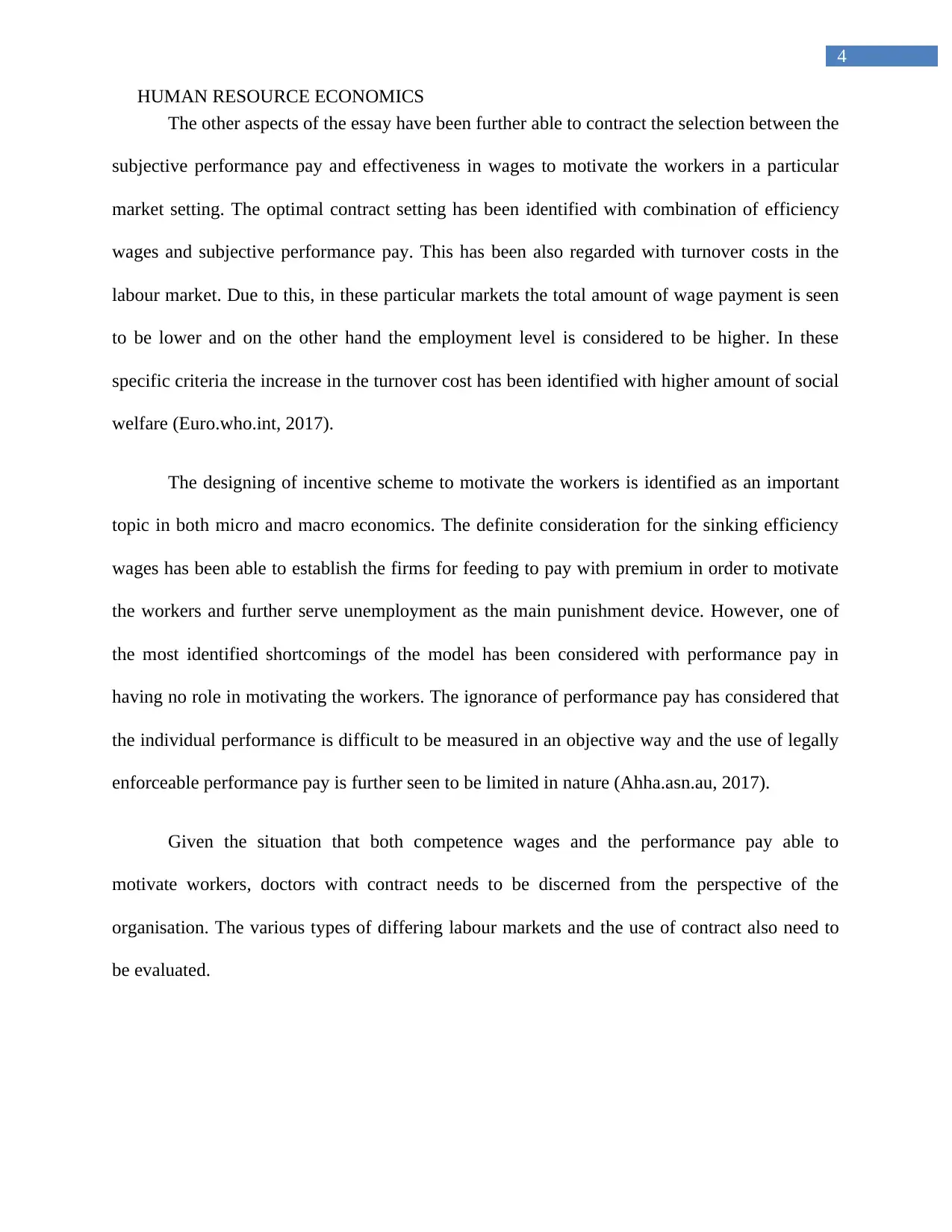
4
HUMAN RESOURCE ECONOMICS
The other aspects of the essay have been further able to contract the selection between the
subjective performance pay and effectiveness in wages to motivate the workers in a particular
market setting. The optimal contract setting has been identified with combination of efficiency
wages and subjective performance pay. This has been also regarded with turnover costs in the
labour market. Due to this, in these particular markets the total amount of wage payment is seen
to be lower and on the other hand the employment level is considered to be higher. In these
specific criteria the increase in the turnover cost has been identified with higher amount of social
welfare (Euro.who.int, 2017).
The designing of incentive scheme to motivate the workers is identified as an important
topic in both micro and macro economics. The definite consideration for the sinking efficiency
wages has been able to establish the firms for feeding to pay with premium in order to motivate
the workers and further serve unemployment as the main punishment device. However, one of
the most identified shortcomings of the model has been considered with performance pay in
having no role in motivating the workers. The ignorance of performance pay has considered that
the individual performance is difficult to be measured in an objective way and the use of legally
enforceable performance pay is further seen to be limited in nature (Ahha.asn.au, 2017).
Given the situation that both competence wages and the performance pay able to
motivate workers, doctors with contract needs to be discerned from the perspective of the
organisation. The various types of differing labour markets and the use of contract also need to
be evaluated.
HUMAN RESOURCE ECONOMICS
The other aspects of the essay have been further able to contract the selection between the
subjective performance pay and effectiveness in wages to motivate the workers in a particular
market setting. The optimal contract setting has been identified with combination of efficiency
wages and subjective performance pay. This has been also regarded with turnover costs in the
labour market. Due to this, in these particular markets the total amount of wage payment is seen
to be lower and on the other hand the employment level is considered to be higher. In these
specific criteria the increase in the turnover cost has been identified with higher amount of social
welfare (Euro.who.int, 2017).
The designing of incentive scheme to motivate the workers is identified as an important
topic in both micro and macro economics. The definite consideration for the sinking efficiency
wages has been able to establish the firms for feeding to pay with premium in order to motivate
the workers and further serve unemployment as the main punishment device. However, one of
the most identified shortcomings of the model has been considered with performance pay in
having no role in motivating the workers. The ignorance of performance pay has considered that
the individual performance is difficult to be measured in an objective way and the use of legally
enforceable performance pay is further seen to be limited in nature (Ahha.asn.au, 2017).
Given the situation that both competence wages and the performance pay able to
motivate workers, doctors with contract needs to be discerned from the perspective of the
organisation. The various types of differing labour markets and the use of contract also need to
be evaluated.
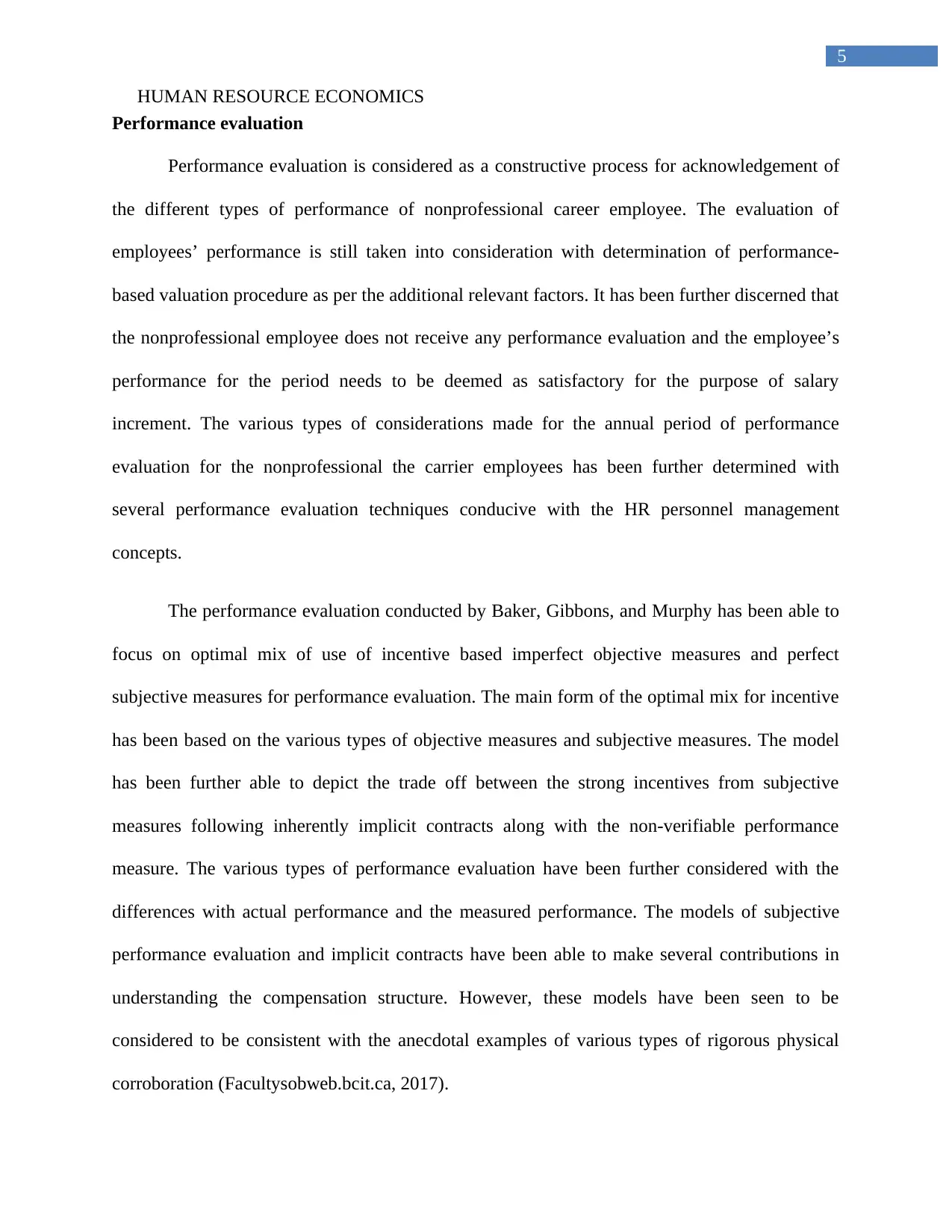
5
HUMAN RESOURCE ECONOMICS
Performance evaluation
Performance evaluation is considered as a constructive process for acknowledgement of
the different types of performance of nonprofessional career employee. The evaluation of
employees’ performance is still taken into consideration with determination of performance-
based valuation procedure as per the additional relevant factors. It has been further discerned that
the nonprofessional employee does not receive any performance evaluation and the employee’s
performance for the period needs to be deemed as satisfactory for the purpose of salary
increment. The various types of considerations made for the annual period of performance
evaluation for the nonprofessional the carrier employees has been further determined with
several performance evaluation techniques conducive with the HR personnel management
concepts.
The performance evaluation conducted by Baker, Gibbons, and Murphy has been able to
focus on optimal mix of use of incentive based imperfect objective measures and perfect
subjective measures for performance evaluation. The main form of the optimal mix for incentive
has been based on the various types of objective measures and subjective measures. The model
has been further able to depict the trade off between the strong incentives from subjective
measures following inherently implicit contracts along with the non-verifiable performance
measure. The various types of performance evaluation have been further considered with the
differences with actual performance and the measured performance. The models of subjective
performance evaluation and implicit contracts have been able to make several contributions in
understanding the compensation structure. However, these models have been seen to be
considered to be consistent with the anecdotal examples of various types of rigorous physical
corroboration (Facultysobweb.bcit.ca, 2017).
HUMAN RESOURCE ECONOMICS
Performance evaluation
Performance evaluation is considered as a constructive process for acknowledgement of
the different types of performance of nonprofessional career employee. The evaluation of
employees’ performance is still taken into consideration with determination of performance-
based valuation procedure as per the additional relevant factors. It has been further discerned that
the nonprofessional employee does not receive any performance evaluation and the employee’s
performance for the period needs to be deemed as satisfactory for the purpose of salary
increment. The various types of considerations made for the annual period of performance
evaluation for the nonprofessional the carrier employees has been further determined with
several performance evaluation techniques conducive with the HR personnel management
concepts.
The performance evaluation conducted by Baker, Gibbons, and Murphy has been able to
focus on optimal mix of use of incentive based imperfect objective measures and perfect
subjective measures for performance evaluation. The main form of the optimal mix for incentive
has been based on the various types of objective measures and subjective measures. The model
has been further able to depict the trade off between the strong incentives from subjective
measures following inherently implicit contracts along with the non-verifiable performance
measure. The various types of performance evaluation have been further considered with the
differences with actual performance and the measured performance. The models of subjective
performance evaluation and implicit contracts have been able to make several contributions in
understanding the compensation structure. However, these models have been seen to be
considered to be consistent with the anecdotal examples of various types of rigorous physical
corroboration (Facultysobweb.bcit.ca, 2017).
⊘ This is a preview!⊘
Do you want full access?
Subscribe today to unlock all pages.

Trusted by 1+ million students worldwide
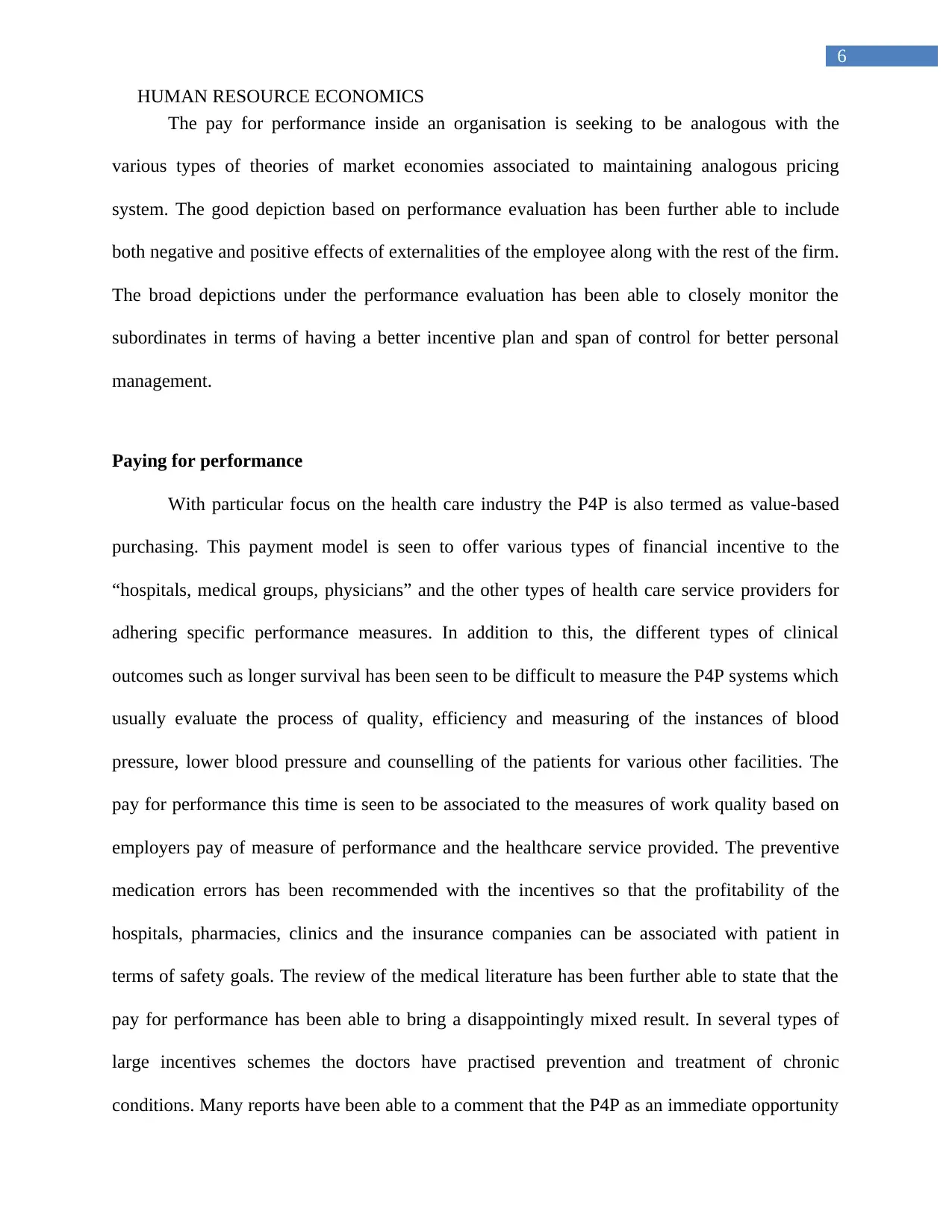
6
HUMAN RESOURCE ECONOMICS
The pay for performance inside an organisation is seeking to be analogous with the
various types of theories of market economies associated to maintaining analogous pricing
system. The good depiction based on performance evaluation has been further able to include
both negative and positive effects of externalities of the employee along with the rest of the firm.
The broad depictions under the performance evaluation has been able to closely monitor the
subordinates in terms of having a better incentive plan and span of control for better personal
management.
Paying for performance
With particular focus on the health care industry the P4P is also termed as value-based
purchasing. This payment model is seen to offer various types of financial incentive to the
“hospitals, medical groups, physicians” and the other types of health care service providers for
adhering specific performance measures. In addition to this, the different types of clinical
outcomes such as longer survival has been seen to be difficult to measure the P4P systems which
usually evaluate the process of quality, efficiency and measuring of the instances of blood
pressure, lower blood pressure and counselling of the patients for various other facilities. The
pay for performance this time is seen to be associated to the measures of work quality based on
employers pay of measure of performance and the healthcare service provided. The preventive
medication errors has been recommended with the incentives so that the profitability of the
hospitals, pharmacies, clinics and the insurance companies can be associated with patient in
terms of safety goals. The review of the medical literature has been further able to state that the
pay for performance has been able to bring a disappointingly mixed result. In several types of
large incentives schemes the doctors have practised prevention and treatment of chronic
conditions. Many reports have been able to a comment that the P4P as an immediate opportunity
HUMAN RESOURCE ECONOMICS
The pay for performance inside an organisation is seeking to be analogous with the
various types of theories of market economies associated to maintaining analogous pricing
system. The good depiction based on performance evaluation has been further able to include
both negative and positive effects of externalities of the employee along with the rest of the firm.
The broad depictions under the performance evaluation has been able to closely monitor the
subordinates in terms of having a better incentive plan and span of control for better personal
management.
Paying for performance
With particular focus on the health care industry the P4P is also termed as value-based
purchasing. This payment model is seen to offer various types of financial incentive to the
“hospitals, medical groups, physicians” and the other types of health care service providers for
adhering specific performance measures. In addition to this, the different types of clinical
outcomes such as longer survival has been seen to be difficult to measure the P4P systems which
usually evaluate the process of quality, efficiency and measuring of the instances of blood
pressure, lower blood pressure and counselling of the patients for various other facilities. The
pay for performance this time is seen to be associated to the measures of work quality based on
employers pay of measure of performance and the healthcare service provided. The preventive
medication errors has been recommended with the incentives so that the profitability of the
hospitals, pharmacies, clinics and the insurance companies can be associated with patient in
terms of safety goals. The review of the medical literature has been further able to state that the
pay for performance has been able to bring a disappointingly mixed result. In several types of
large incentives schemes the doctors have practised prevention and treatment of chronic
conditions. Many reports have been able to a comment that the P4P as an immediate opportunity
Paraphrase This Document
Need a fresh take? Get an instant paraphrase of this document with our AI Paraphraser
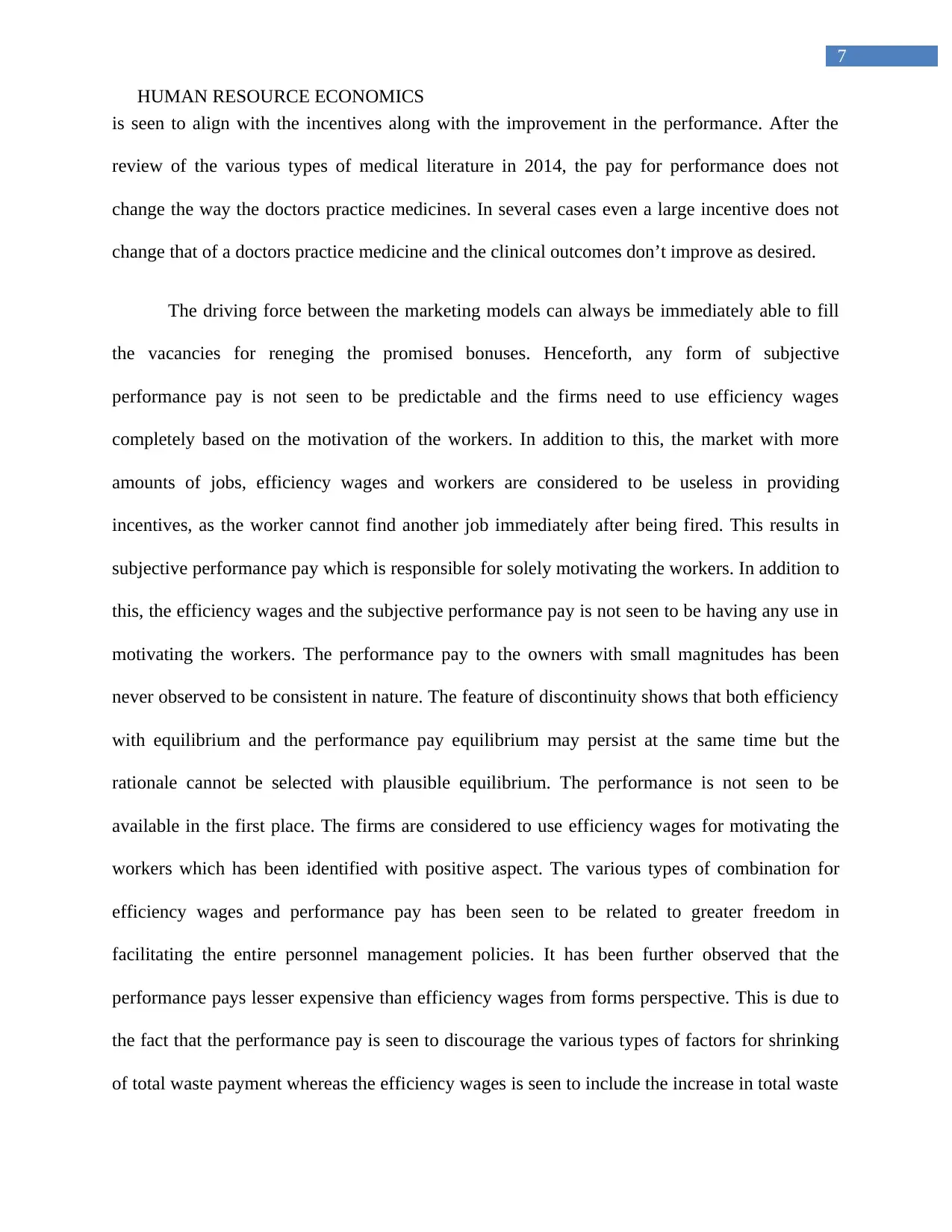
7
HUMAN RESOURCE ECONOMICS
is seen to align with the incentives along with the improvement in the performance. After the
review of the various types of medical literature in 2014, the pay for performance does not
change the way the doctors practice medicines. In several cases even a large incentive does not
change that of a doctors practice medicine and the clinical outcomes don’t improve as desired.
The driving force between the marketing models can always be immediately able to fill
the vacancies for reneging the promised bonuses. Henceforth, any form of subjective
performance pay is not seen to be predictable and the firms need to use efficiency wages
completely based on the motivation of the workers. In addition to this, the market with more
amounts of jobs, efficiency wages and workers are considered to be useless in providing
incentives, as the worker cannot find another job immediately after being fired. This results in
subjective performance pay which is responsible for solely motivating the workers. In addition to
this, the efficiency wages and the subjective performance pay is not seen to be having any use in
motivating the workers. The performance pay to the owners with small magnitudes has been
never observed to be consistent in nature. The feature of discontinuity shows that both efficiency
with equilibrium and the performance pay equilibrium may persist at the same time but the
rationale cannot be selected with plausible equilibrium. The performance is not seen to be
available in the first place. The firms are considered to use efficiency wages for motivating the
workers which has been identified with positive aspect. The various types of combination for
efficiency wages and performance pay has been seen to be related to greater freedom in
facilitating the entire personnel management policies. It has been further observed that the
performance pays lesser expensive than efficiency wages from forms perspective. This is due to
the fact that the performance pay is seen to discourage the various types of factors for shrinking
of total waste payment whereas the efficiency wages is seen to include the increase in total waste
HUMAN RESOURCE ECONOMICS
is seen to align with the incentives along with the improvement in the performance. After the
review of the various types of medical literature in 2014, the pay for performance does not
change the way the doctors practice medicines. In several cases even a large incentive does not
change that of a doctors practice medicine and the clinical outcomes don’t improve as desired.
The driving force between the marketing models can always be immediately able to fill
the vacancies for reneging the promised bonuses. Henceforth, any form of subjective
performance pay is not seen to be predictable and the firms need to use efficiency wages
completely based on the motivation of the workers. In addition to this, the market with more
amounts of jobs, efficiency wages and workers are considered to be useless in providing
incentives, as the worker cannot find another job immediately after being fired. This results in
subjective performance pay which is responsible for solely motivating the workers. In addition to
this, the efficiency wages and the subjective performance pay is not seen to be having any use in
motivating the workers. The performance pay to the owners with small magnitudes has been
never observed to be consistent in nature. The feature of discontinuity shows that both efficiency
with equilibrium and the performance pay equilibrium may persist at the same time but the
rationale cannot be selected with plausible equilibrium. The performance is not seen to be
available in the first place. The firms are considered to use efficiency wages for motivating the
workers which has been identified with positive aspect. The various types of combination for
efficiency wages and performance pay has been seen to be related to greater freedom in
facilitating the entire personnel management policies. It has been further observed that the
performance pays lesser expensive than efficiency wages from forms perspective. This is due to
the fact that the performance pay is seen to discourage the various types of factors for shrinking
of total waste payment whereas the efficiency wages is seen to include the increase in total waste
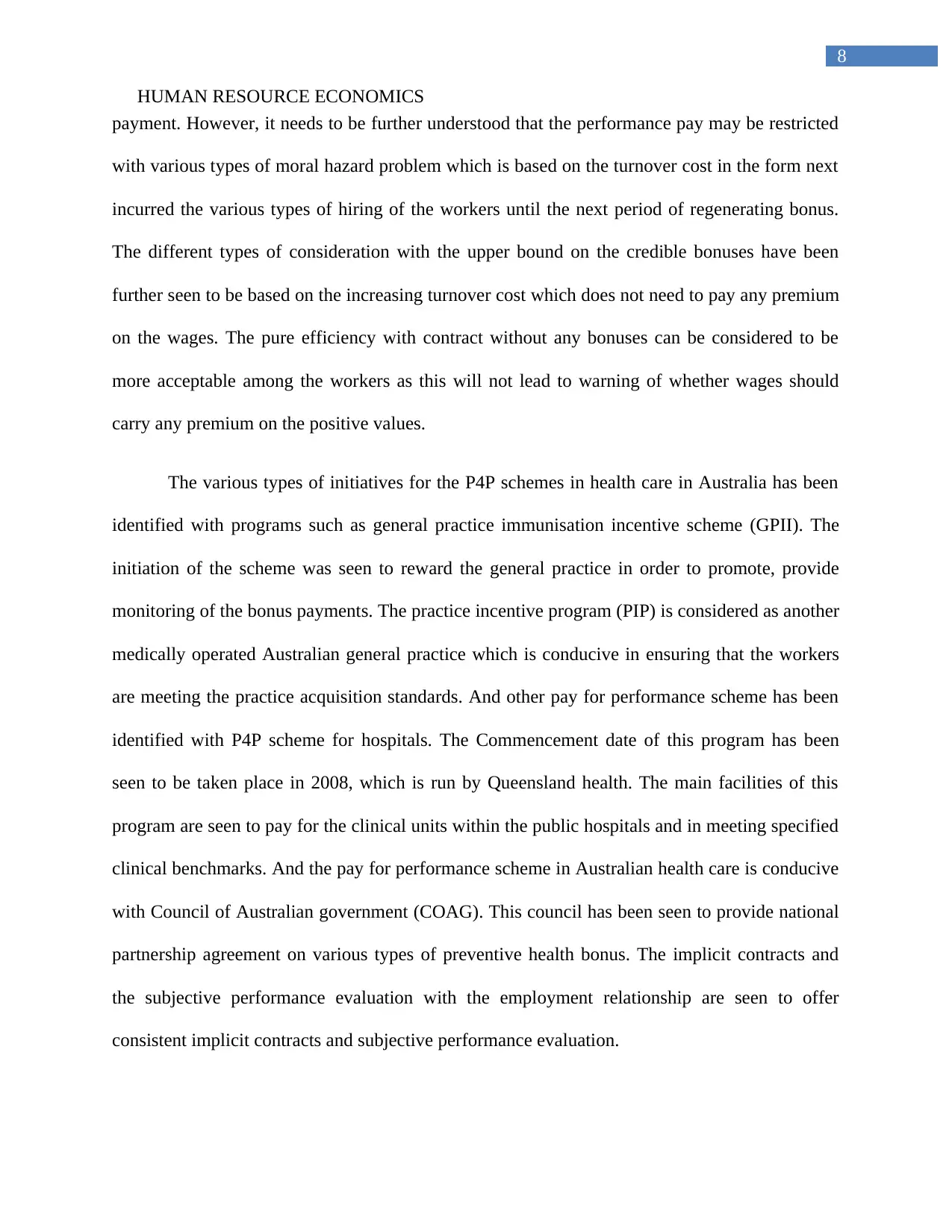
8
HUMAN RESOURCE ECONOMICS
payment. However, it needs to be further understood that the performance pay may be restricted
with various types of moral hazard problem which is based on the turnover cost in the form next
incurred the various types of hiring of the workers until the next period of regenerating bonus.
The different types of consideration with the upper bound on the credible bonuses have been
further seen to be based on the increasing turnover cost which does not need to pay any premium
on the wages. The pure efficiency with contract without any bonuses can be considered to be
more acceptable among the workers as this will not lead to warning of whether wages should
carry any premium on the positive values.
The various types of initiatives for the P4P schemes in health care in Australia has been
identified with programs such as general practice immunisation incentive scheme (GPII). The
initiation of the scheme was seen to reward the general practice in order to promote, provide
monitoring of the bonus payments. The practice incentive program (PIP) is considered as another
medically operated Australian general practice which is conducive in ensuring that the workers
are meeting the practice acquisition standards. And other pay for performance scheme has been
identified with P4P scheme for hospitals. The Commencement date of this program has been
seen to be taken place in 2008, which is run by Queensland health. The main facilities of this
program are seen to pay for the clinical units within the public hospitals and in meeting specified
clinical benchmarks. And the pay for performance scheme in Australian health care is conducive
with Council of Australian government (COAG). This council has been seen to provide national
partnership agreement on various types of preventive health bonus. The implicit contracts and
the subjective performance evaluation with the employment relationship are seen to offer
consistent implicit contracts and subjective performance evaluation.
HUMAN RESOURCE ECONOMICS
payment. However, it needs to be further understood that the performance pay may be restricted
with various types of moral hazard problem which is based on the turnover cost in the form next
incurred the various types of hiring of the workers until the next period of regenerating bonus.
The different types of consideration with the upper bound on the credible bonuses have been
further seen to be based on the increasing turnover cost which does not need to pay any premium
on the wages. The pure efficiency with contract without any bonuses can be considered to be
more acceptable among the workers as this will not lead to warning of whether wages should
carry any premium on the positive values.
The various types of initiatives for the P4P schemes in health care in Australia has been
identified with programs such as general practice immunisation incentive scheme (GPII). The
initiation of the scheme was seen to reward the general practice in order to promote, provide
monitoring of the bonus payments. The practice incentive program (PIP) is considered as another
medically operated Australian general practice which is conducive in ensuring that the workers
are meeting the practice acquisition standards. And other pay for performance scheme has been
identified with P4P scheme for hospitals. The Commencement date of this program has been
seen to be taken place in 2008, which is run by Queensland health. The main facilities of this
program are seen to pay for the clinical units within the public hospitals and in meeting specified
clinical benchmarks. And the pay for performance scheme in Australian health care is conducive
with Council of Australian government (COAG). This council has been seen to provide national
partnership agreement on various types of preventive health bonus. The implicit contracts and
the subjective performance evaluation with the employment relationship are seen to offer
consistent implicit contracts and subjective performance evaluation.
⊘ This is a preview!⊘
Do you want full access?
Subscribe today to unlock all pages.

Trusted by 1+ million students worldwide
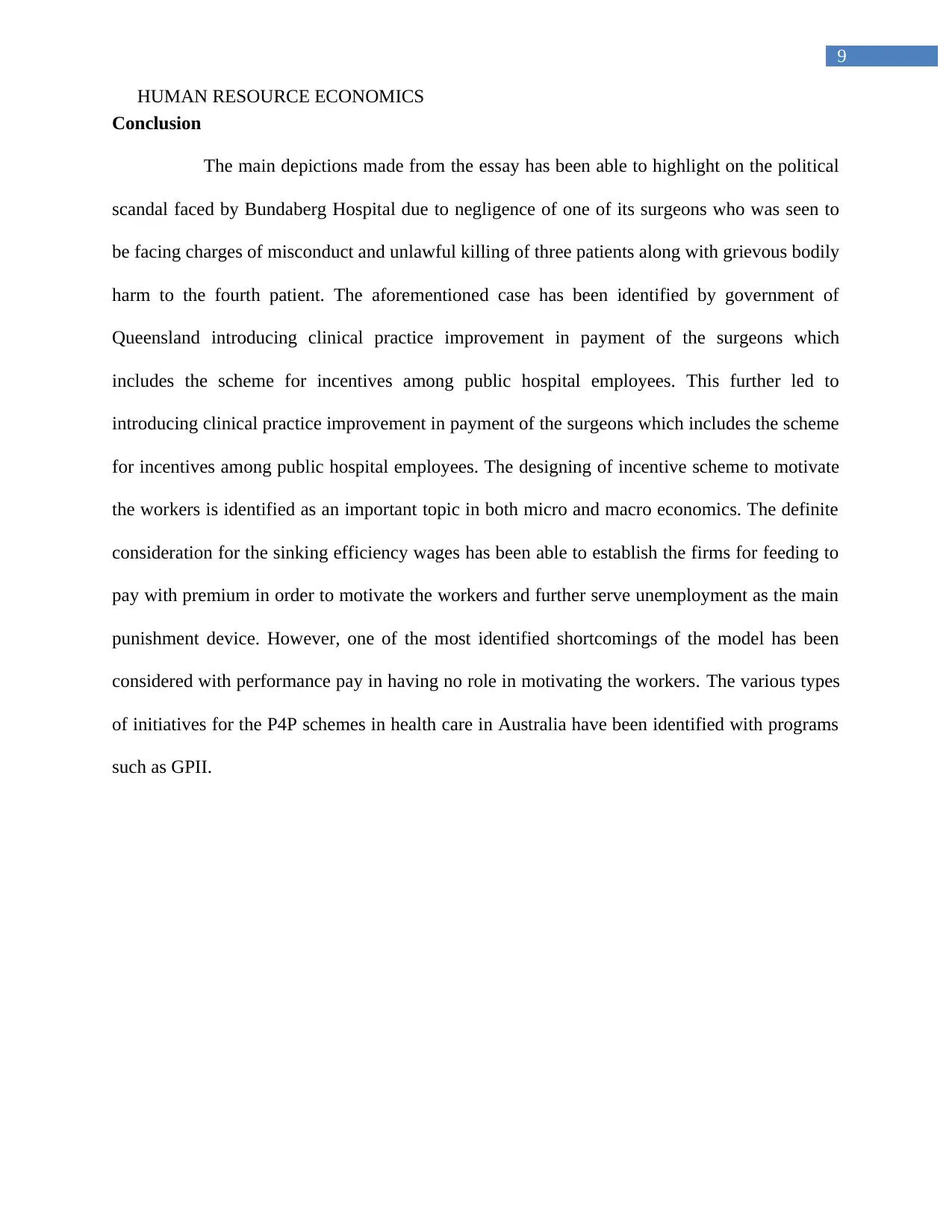
9
HUMAN RESOURCE ECONOMICS
Conclusion
The main depictions made from the essay has been able to highlight on the political
scandal faced by Bundaberg Hospital due to negligence of one of its surgeons who was seen to
be facing charges of misconduct and unlawful killing of three patients along with grievous bodily
harm to the fourth patient. The aforementioned case has been identified by government of
Queensland introducing clinical practice improvement in payment of the surgeons which
includes the scheme for incentives among public hospital employees. This further led to
introducing clinical practice improvement in payment of the surgeons which includes the scheme
for incentives among public hospital employees. The designing of incentive scheme to motivate
the workers is identified as an important topic in both micro and macro economics. The definite
consideration for the sinking efficiency wages has been able to establish the firms for feeding to
pay with premium in order to motivate the workers and further serve unemployment as the main
punishment device. However, one of the most identified shortcomings of the model has been
considered with performance pay in having no role in motivating the workers. The various types
of initiatives for the P4P schemes in health care in Australia have been identified with programs
such as GPII.
HUMAN RESOURCE ECONOMICS
Conclusion
The main depictions made from the essay has been able to highlight on the political
scandal faced by Bundaberg Hospital due to negligence of one of its surgeons who was seen to
be facing charges of misconduct and unlawful killing of three patients along with grievous bodily
harm to the fourth patient. The aforementioned case has been identified by government of
Queensland introducing clinical practice improvement in payment of the surgeons which
includes the scheme for incentives among public hospital employees. This further led to
introducing clinical practice improvement in payment of the surgeons which includes the scheme
for incentives among public hospital employees. The designing of incentive scheme to motivate
the workers is identified as an important topic in both micro and macro economics. The definite
consideration for the sinking efficiency wages has been able to establish the firms for feeding to
pay with premium in order to motivate the workers and further serve unemployment as the main
punishment device. However, one of the most identified shortcomings of the model has been
considered with performance pay in having no role in motivating the workers. The various types
of initiatives for the P4P schemes in health care in Australia have been identified with programs
such as GPII.
Paraphrase This Document
Need a fresh take? Get an instant paraphrase of this document with our AI Paraphraser
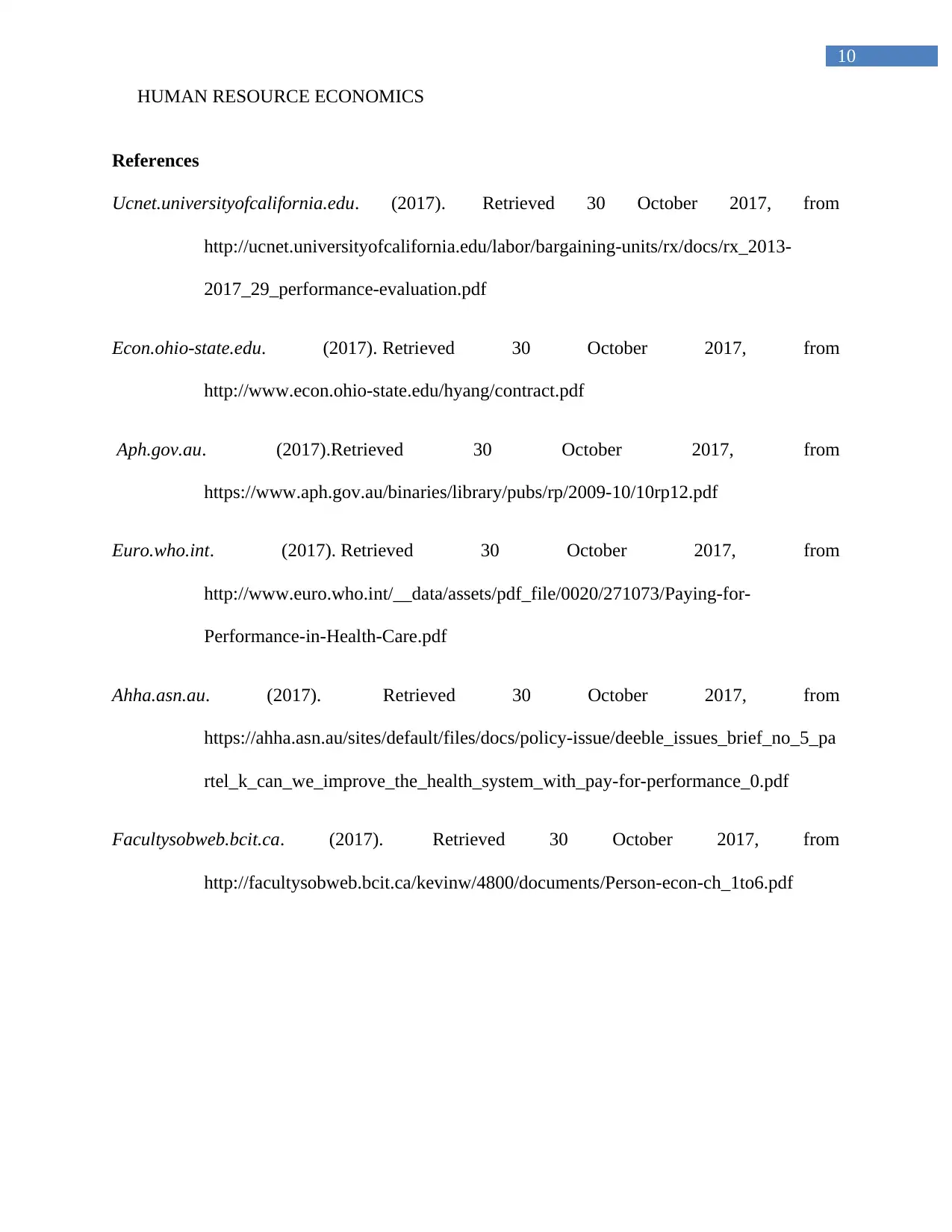
10
HUMAN RESOURCE ECONOMICS
References
Ucnet.universityofcalifornia.edu. (2017). Retrieved 30 October 2017, from
http://ucnet.universityofcalifornia.edu/labor/bargaining-units/rx/docs/rx_2013-
2017_29_performance-evaluation.pdf
Econ.ohio-state.edu. (2017). Retrieved 30 October 2017, from
http://www.econ.ohio-state.edu/hyang/contract.pdf
Aph.gov.au. (2017).Retrieved 30 October 2017, from
https://www.aph.gov.au/binaries/library/pubs/rp/2009-10/10rp12.pdf
Euro.who.int. (2017). Retrieved 30 October 2017, from
http://www.euro.who.int/__data/assets/pdf_file/0020/271073/Paying-for-
Performance-in-Health-Care.pdf
Ahha.asn.au. (2017). Retrieved 30 October 2017, from
https://ahha.asn.au/sites/default/files/docs/policy-issue/deeble_issues_brief_no_5_pa
rtel_k_can_we_improve_the_health_system_with_pay-for-performance_0.pdf
Facultysobweb.bcit.ca. (2017). Retrieved 30 October 2017, from
http://facultysobweb.bcit.ca/kevinw/4800/documents/Person-econ-ch_1to6.pdf
HUMAN RESOURCE ECONOMICS
References
Ucnet.universityofcalifornia.edu. (2017). Retrieved 30 October 2017, from
http://ucnet.universityofcalifornia.edu/labor/bargaining-units/rx/docs/rx_2013-
2017_29_performance-evaluation.pdf
Econ.ohio-state.edu. (2017). Retrieved 30 October 2017, from
http://www.econ.ohio-state.edu/hyang/contract.pdf
Aph.gov.au. (2017).Retrieved 30 October 2017, from
https://www.aph.gov.au/binaries/library/pubs/rp/2009-10/10rp12.pdf
Euro.who.int. (2017). Retrieved 30 October 2017, from
http://www.euro.who.int/__data/assets/pdf_file/0020/271073/Paying-for-
Performance-in-Health-Care.pdf
Ahha.asn.au. (2017). Retrieved 30 October 2017, from
https://ahha.asn.au/sites/default/files/docs/policy-issue/deeble_issues_brief_no_5_pa
rtel_k_can_we_improve_the_health_system_with_pay-for-performance_0.pdf
Facultysobweb.bcit.ca. (2017). Retrieved 30 October 2017, from
http://facultysobweb.bcit.ca/kevinw/4800/documents/Person-econ-ch_1to6.pdf
1 out of 11
Related Documents
Your All-in-One AI-Powered Toolkit for Academic Success.
+13062052269
info@desklib.com
Available 24*7 on WhatsApp / Email
![[object Object]](/_next/static/media/star-bottom.7253800d.svg)
Unlock your academic potential
Copyright © 2020–2025 A2Z Services. All Rights Reserved. Developed and managed by ZUCOL.





